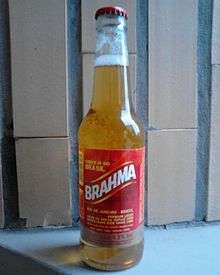Beer in Brazil
Brazil is the world's third largest market for beer with over 13.2 billion litres produced in 2012 [1] and annual per capita consumption of 62,2 litres.[1]
History

The tradition of brewing in Brazil dates back to German immigration in the early nineteenth century. The first breweries date from the 1830s, the brand Bohemia is claimed to be the first Brazilian beer, with production starting in 1853 in the city of Petrópolis, Rio de Janeiro and is the oldest Brazilian beer which is still under production (now owned by Anheuser–Busch InBev). Naturally, many breweries appeared and disappeared in that period like Ritter from Rio Grande do Sul and Imperial Fábrica de Cerveja Nacional from Rio de Janeiro. Two important brands, Antarctica and Brahma, started production in the 1880s.
Market
Pilsner beers are the most consumed in Brazil (98% of the market share), with only a limited choice of other kinds.
The majority of the market belongs to AmBev, the owner of the Brahma, Antarctica, Bohemia and Skol brands. Brazil's largest brewer was formed in 1999 from the merger of the two biggest brands, Brahma and Antarctica. In 2004, Ambev merged with Belgium's Interbrew (Stella Artois, Becks, Staropramen and many others) to form the world's largest brewer, now known as InBev. After the merger, Grupo Schincariol became the largest Brazilian-owned brewery in the country. Grupo Schincariol is, since 2011, a subsidiary of Japanese beverage company Kirin Brewery Company, and the name changed to Brasil Kirin.[2]
In 2002, Molson Coors bought Brazil's second largest brewery Kaiser. In 2006, the Mexican FEMSA Cerveza acquired 68% of Kaiser Brewery from Molson Coors. Molson Coors still holds 15% of Kaiser brewery shares, and Heineken holds the remaining 17%. In 2006, FEMSA Cerveza released the Mexican brand Sol in the Brazilian market to compete to the biggest Inbev brands with poor results. In 2010, Heineken bought all FEMSA's brewery including the Brazilian unit.
There are a number of microbreweries in Brazil, the emergence of which are a relatively recent phenomenon. Some of the better renowned microbreweries include;
- Baden Baden (Recognised as the first microbrewery in Brazil)
- Eisenbahn
- Wäls
- Colorado
- DaDo Bier
- Cervejaria Backer
Curitiba and Blumenau are cities with several breweries: Curitiba: WayBeer, BodeBrown, Wensky Beer, Klein Bier, GaudenBier, Cervejas Pagan, Bierhoff, Morada and Asgard. Blumenau: Eisenbahn (Schincariol brand), Bierland and some soft American lager breweries.
Over the past decade or so Brazil has imported more and more brands of beer from Europe (particularly from Belgium) and the USA. These imports are a lot more expensive than locally brewed beers. However, there are a growing number of bars and beer shops dedicating themselves to selling a large range of craft and imported beer. Some international brands are actually produced in Brazil, such as Stella Artois and Heineken, but all are dedicated to the premium market with very small market share.
Market share in 2009: Ambev (Inbev) (70%), Grupo Schincariol (11,6%), Petrópolis brewery (9,8%), Heineken (6,9%), others (1,73%).
Most popular brands in 2005: Skol (32,6%), Brahma (20,4%), Antarctica (13,6%), Nova Schin (10,2%), Kaiser (8,9%).
Economy
Beer is the most competitive sector of the alcoholic drinks market in Brazil, and the big global beer companies like InBev and FEMSA compete strongly for market share.[3]
Carnival
In the Brazilian Carnival period there is an explosion in beer consumption. In these 4 days, 400 million liters (or around 4% of the yearly production) are consumed. In November with the approach of summer, the manufacture and investment in marketing triples. International tourists find that domestic and local beers are much less expensive than imported brands.[4]
See also
References
- 1 2 Market Reports - Barth-Haas Group
- ↑ "Schincariol Group to become a Wholly-Owned Subsidiary of Kirin". November 4, 2011.
- ↑ euromonitor.com. Retrieved 31 August 2008
- ↑ "Rio Carnival FAQ".
